Prince of Persia: The Lost Crown review – a stunning revival that turns back time
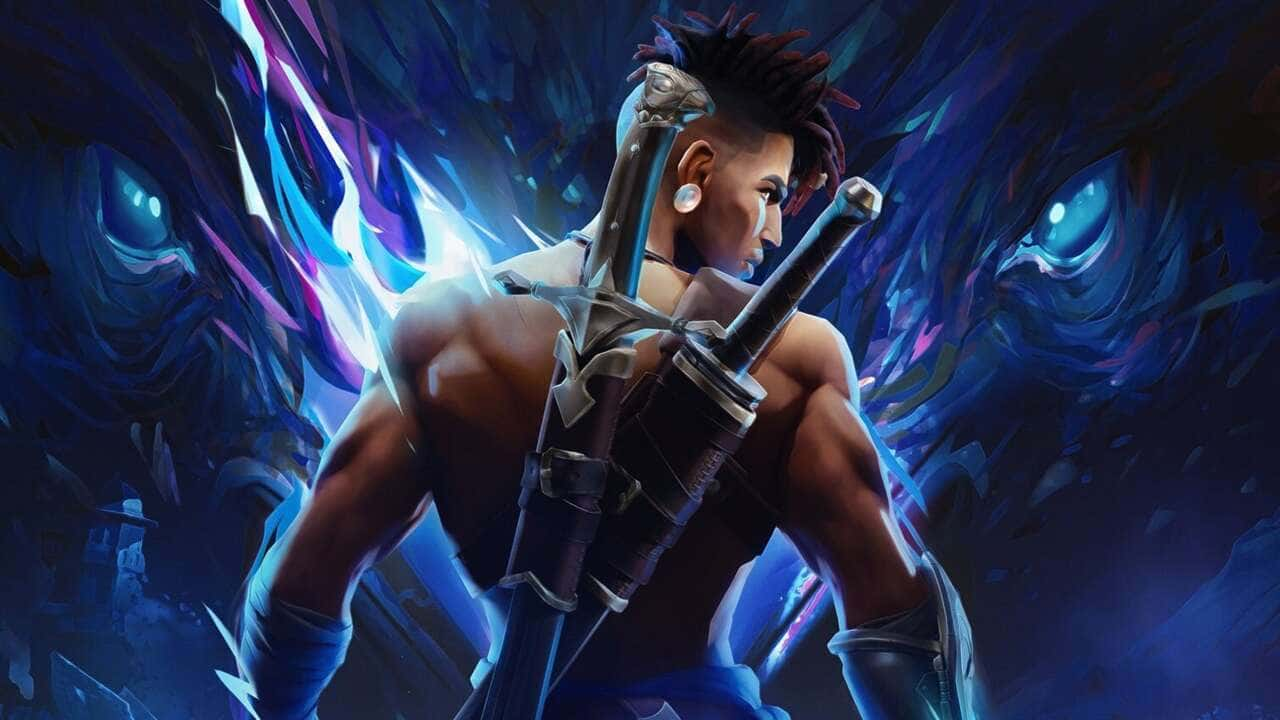 Ubisoft
UbisoftPrince of Persia: The Lost Crown sees Ubisoft’s return to a long-dormant franchise. However, can the revival make a name for itself or is it bound to be stuck in time?
There was a time when Prince of Persia was one of Ubisoft’s crown jewels. The franchise has an extremely long legacy and a deep history that spans all the way back to 1989 and the Apple II.
It’s important to establish that, as if you’ve not been tracking games before the last decade, you’d be forgiven for not even really knowing about Prince of Persia. The series hasn’t gotten a main title game since 2010 with The Forgotten Sands, and in the broader cultural zeitgeist, the film adaption starring Jake Gyllenhaal in the same year.
The reason for Prince of Persia’s disappearance isn’t exactly a mystery either. What was once one of Ubisoft’s most profitable franchises became supplanted by Assassin’s Creed. Famously, that series came to be out of experimentation of a Prince of Persia open-world game. Ubisoft became more enamored with Assassins as it let them explore more history, thus rendering Prince of Persia obsolete. There just wasn’t room for two historical-platforming-assassinating-with-added-time-weirdness franchises.
And on that shelf, Prince of Persia has sat for the best part of a decade and a half, bar some remasters and mobile outings. That was until Ubisoft Montpellier stepped in. This particular wing of Ubisoft has a great history of exceptional 2.5D platformers, especially with them being the custodians of Rayman. This match, as it turns out, was made in heaven. Montpellier has found the perfect niche for Prince of Persia as a reimagined Metroidvania, making it completely distinct from Assassin’s Creed, and finding a new voice for the franchise to flourish.
Prince of Persia: The Lost Crown – Key details
- Price: $49.99/£49.99
- Developer: Ubisoft Montpellier
- Release Date: January 18, 2024
- Platforms: PS4, PS5, Nintendo Switch, Xbox Series X|S, & PC
Prince of Persiavania
Since Sands of Time in 2003 and onwards, Prince of Persia has been a 3D action game with a focus on platforming puzzles. Montpellier has sidestepped this by reimagining the Prince of Persia formula and putting it into a sidescrolling form once again. This brings it closer to its original roots. This really works and helps define what could be a new era of Prince of Persia as something unique in the current landscape.
However, this isn’t just 2D puzzle platformer, at least in its broader form. No, instead this is a Metroidvania, straight up. Some people hate that categorization – so to put it into concrete terms, Prince of Persia: The Lost Crown is clearly a modern riff on Castlevania: Symphony of the Night. While games like Hollow Knight and the Ori series have been popular recent examples of the genre, The Lost Crown feels even more faithful to Konami’s classic.
If you’ve not played that game, essentially you move around a connected world, full of different biomes. You unlock various powers as you go, soon able to reach new areas to follow the story campaign, facing off against various bosses. This 20-hour adventure is full to the brim with inventive ideas, platforming, invigorating combat, and staggering bosses too.
Mount up
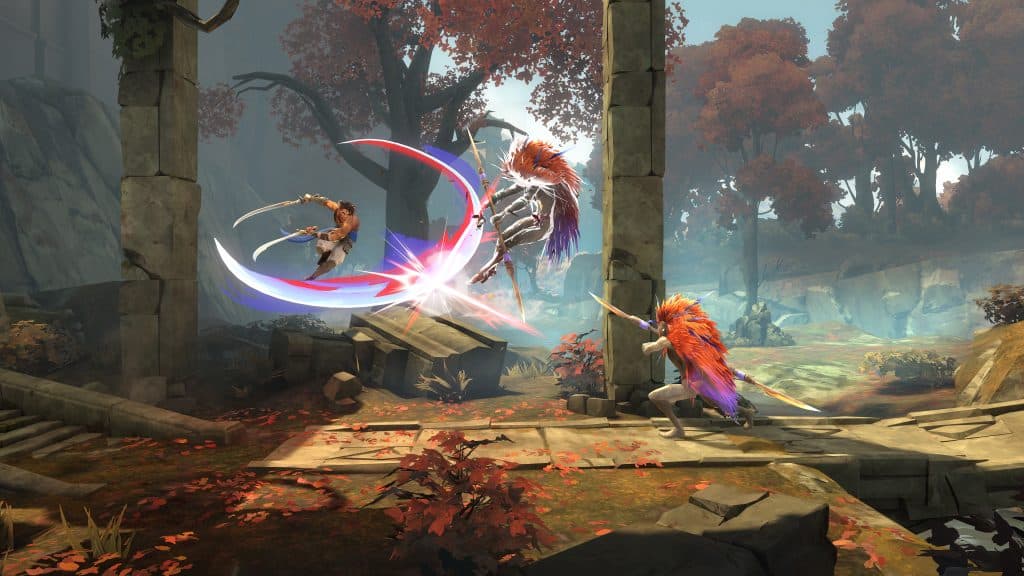
The vast majority of Prince of Persia: The Lost Crown takes place in Mount Qaf. It’s a gorgeously crafted location that will have you exploring for hours, hiding some truly devious puzzles and enemies throughout its countless nooks and crannies.
Playing as Sargon, a member of the protective group the Immortals, you are thrust into Mount Qaf to find a kidnapped Prince. Once there, you find a lost city cursed by time, and a story of intrigue unfolds from there as you begin to wrestle with various characters and time itself.
It’s a simple story setup, but it’s to get you out and about in this gorgeous location. As you progress, you get access to powers, such as double jumps, dashes, the ability to freeze yourself in space and return to that point, and more. Every time you get a new power it’s always exciting as once previously hard to traverse areas become delightfully trivial. That is until you realize Ubisoft Montpellier is going to use that newfound power to make even more fiendishly complex platforming puzzles.
Some of the later portions of the game are a joy to figure out as you have to string abilities together in ever-increasing difficulty, often all without giving you the time to get a breather. (That said, if it proves to be too much, the game has some exceptional accessibility options.) In these moments, it can create these breathless sequences where you’re trying to hit all of your traversal abilities perfectly. Once you can pull it all together, it feels completely gratifying. Traversal and the puzzle platforming are exceptional, especially as you begin to unlock more and more of those coveted powers.
Naughts and bosses
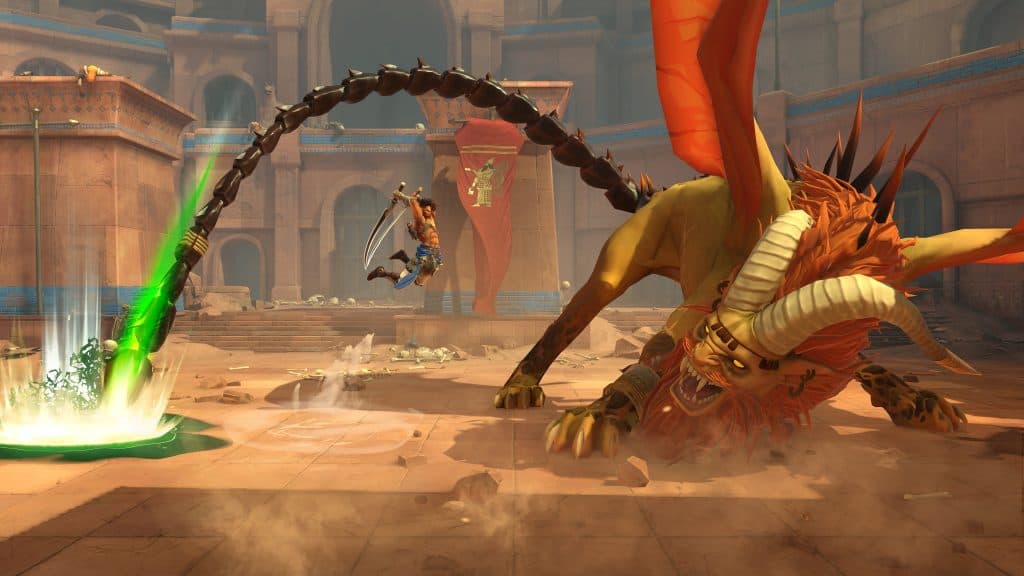
Of course, platforming puzzles and moving around the world is great and all, but it’d be nothing without great combat. Thankfully Montpellier has served a refined gourmet plate for anyone who has a palette for 2D combat.
You can do pretty well deep into the game just by spamming the attack button over and over, but there are moments where the game will want you to take a more deliberate approach. By participating in the worthwhile training, you soon find out how much there is to consider and dig into, from defensive moves, combos that utilize all of your special powers, as well as things like launchers and air juggles.
You can become a master when you start to cleverly string these combos together. The first time you realize you can charge an attack, create a double of yourself, let off the attack, then return to your double, and then let it off again, you realize there’s depth here that is only limited by your imagination for stringing your arsenal together.
Nowhere does the combat come together better than in the game’s many, grueling boss battles. These can be very challenging and often will be the points where you’ll get a serious reality check on your mastery of the game’s systems. It’s not uncommon to come up against a boss and realize you need to leave, and get stronger by upgrading your equipment and life.
But when you get into these tense boss fights, they’re a thrill of adrenaline and artistry. Figure out how to dodge certain attacks and get the boss to half-health? Well, they’re now going to do a cutscene-assisted anime-move on you, with some of the most stylish visual execution you’ll see, and morph into their next, more challenging phase. These boss fights are Prince of Persia at its pinnacle and are so exhilarating that it’s hard not to feel a little remorseful once you do best as a boss, as it means, you won’t be fighting them again.
Twilight hour
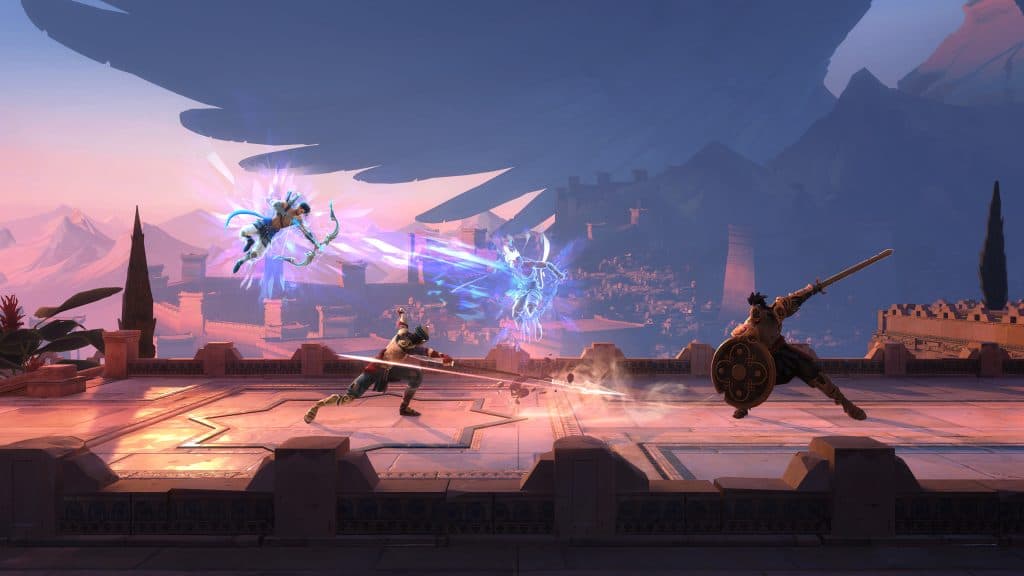
These boss fights look incredible due to the game’s vibrant art direction and visual execution. It’s clear Ubisoft Montpellier, as showcased in their Rayman games, has a knack for embodying everything about ‘style’, particularly in a 2D form.
The Lost Crown very clearly pulls from anime for many of its flourishes, especially concerning kinetic action. Some of the moves bosses do on you are things that feel ripped from the screen of Naruto or Dragonball Z, but thanks to the authoritative stamp of the developers and the unique aspects of the property, it never feels derivative. It’s not rare to miss an all-important parry, to then be hoisted up, thrown around the screen, and have it all finish in a massive Kamehamiaha-esque energy blast sending you sprawling. These visuals combine with the difficulty of boss encounters, to create something really special.
However, while that’s during all the exciting parts, I’d be remiss not to mention how good the game looks outside of these encounters too. For being set in one, time-locked location, Mount Qaf has a plethora of biomes, keeping everything visually fresh. From Persian monuments to a raging sea frozen in time, to snow-covered mountains, to the gross, dark depths of the sewers, Ubisoft stretches this location far and wide – but importantly, it never breaks. It all still feels like it holds together as one location which is a real achievement.
Add on top of this, some of the breathtaking vistas, lovingly created by exceptionally talented artists, and it’s hard to argue this isn’t one of the most artistically pleasing games in a while.
Give me a minute
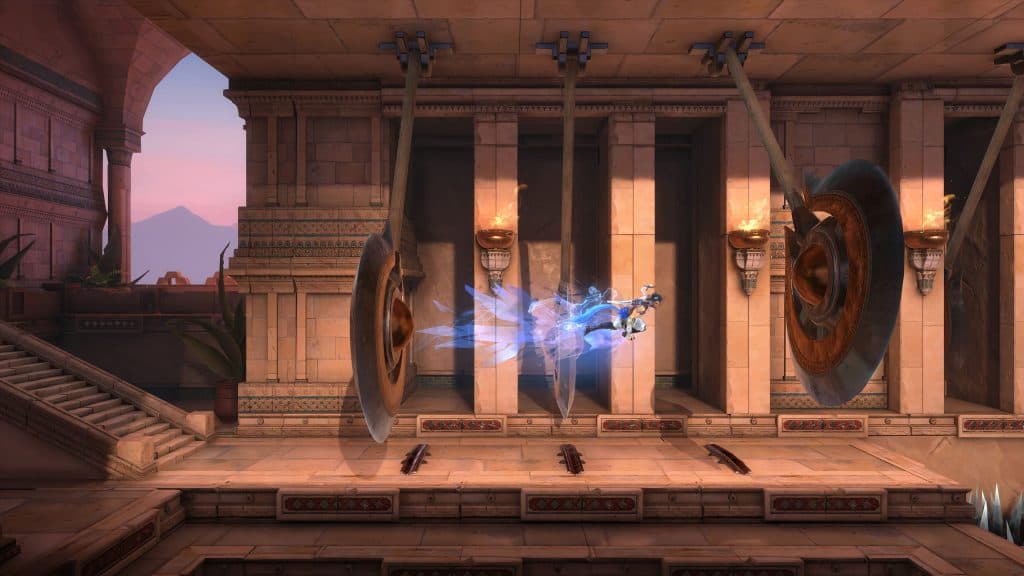
It’s not all perfect, mind. While you might think in a Metroidvania, the strength of the story wouldn’t matter, The Lost Crown does try to do some interesting things. There is more here than, ‘go to location, save the prince’. There are character moments, some twists, and interpersonal relationships that elevate the game past most in the genre.
That’s why it’s sad that after some strong moments and boss fights, the game sort of peters out. The presentation of some of the later scenes feels like a strange step down from what came before, the game losing a bit of its trademark flair towards the end. This, in the grand scheme, is a tiny gripe, but it did make rolling the credits feel a little anti-climactic.
Of course, I wasn’t necessarily here for the story. The only reason this ended up hitting harder was because there were times earlier on that Ubisoft Montpellier tried to elevate the narrative, and raised hopes it could meet that ambition.
Also, this may be circumstantial, but in one boss fight, Sargon turned invisible, and immune to damage, trivializing it. Of course, I could have stopped and reloaded, and hopefully, it will be patched in time, but it was a strange glitch that hurt a big moment in the campaign for me.
The best Persian of itself
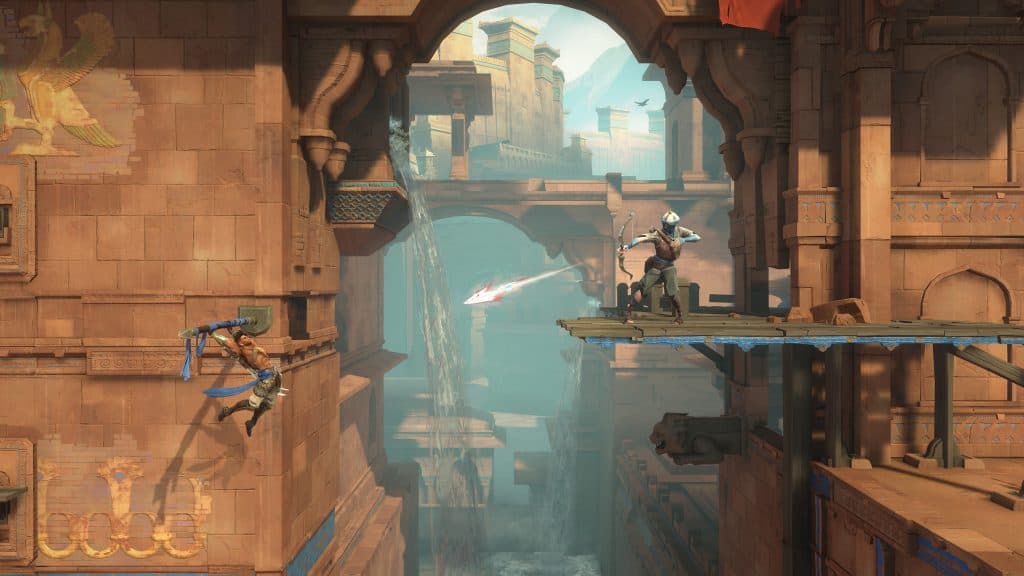
None of that really takes away from Prince of Persia: The Lost Crown’s excellence though. The title is an exceptional realization of a fresh new take on this series that hopefully cements it for the future. And hopefully, there is a future. This is Prince of Persia stepping out of the long shadow Assassin’s Creed has cast on the series for over a decade and finding its new identity. It deserves to be expanded on, and it’s the direction this franchise should head in the future.
If you’re a fan of Metroidvanias and hell, even if you are not, you should absolutely try this game. It’s a beautiful realization of a concept, with an emergent depth that is easy to be swept up in. If ever there was a style award, it’d be surprising if anything beat it this year.
Verdict – 5/5
Ubisoft Montpellier has brought an invigorating energy, with a breathtaking art style, impressively expressive combat, mindstretching platform puzzles, and deeply challenging bosses. When it is all coming together in an audio-visual crescendo, it’s a thing to behold. This ode to Symphony of the Night and other greats in the genre understands what made those so good, and finds new life. Prince of Persia: The Lost Crown is an absolute triumph, charting the future for this fallen franchise. Here’s hoping it finds its audience because it would be a tragedy to have something this good lost to time once again.
If you click on a product link on this page we may earn a small affiliate commission